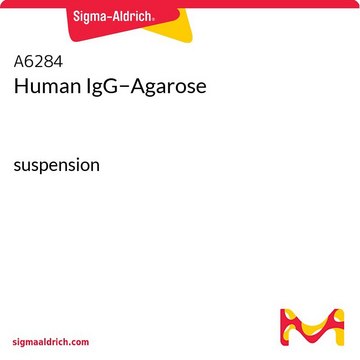Wszystkie zdjęcia(1)
Kluczowe dokumenty
A3543
Anti-Human IgG (whole molecule)−Agarose antibody produced in goat
IgG fraction of antiserum, PBS suspension
Zaloguj sięWyświetlanie cen organizacyjnych i kontraktowych
About This Item
Polecane produkty
pochodzenie biologiczne
goat
białko sprzężone
agarose conjugate
forma przeciwciała
IgG fraction of antiserum
rodzaj przeciwciała
secondary antibodies
klon
polyclonal
Formularz
PBS suspension
reaktywność gatunkowa
human
zakres etykietowania
~2.4 mg Ab per mL
metody
immunoelectrophoresis: suitable
pojemność
1 mg/mL binding capacity
temp. przechowywania
2-8°C
docelowa modyfikacja potranslacyjna
unmodified
Opis ogólny
Podtyp przeciwciał IgG to najobficiej występujące w surowicy immunoglobuliny układu odpornościowego. Jest on wydzielany przez komórki B i znajduje się we krwi i płynach pozakomórkowych, zapewniając ochronę przed infekcjami wywołanymi przez bakterie, grzyby i wirusy. IgG matki są przekazywane płodowi przez łożysko, co ma kluczowe znaczenie dla obrony immunologicznej noworodka przed infekcjami.
Specyficzność
Anty-ludzkie IgG rozpoznaje ludzkie IgG (całe cząsteczki). Kozie anty-ludzkie są oczyszczane za pomocą chromatografii jonowymiennej, a następnie kowalencyjnie wiązane z agarozą.
Immunogen
Zbiorcza normalna surowica ludzka
Zastosowanie
Anty-ludzka IgG (cała cząsteczka) jest odpowiednia do immunoelektroforezy. Usuwanie przeciwciał z normalnej ludzkiej surowicy przeprowadzono przez traktowanie rozcieńczonej surowicy 50 mikrolami koziej antyludzkiej IgG związanej z agarozą (A3543) przez 90 minut w temperaturze 4 °.
Usuwanie przeciwciał z normalnej ludzkiej surowicy przeprowadzono przez traktowanie rozcieńczonej surowicy 50 μl koziej antyludzkiej IgG związanej z agarozą (A3543) przez 90 minut w temperaturze 4 stopni.
Działania biochem./fizjol.
IgG stymuluje klasyczną ścieżkę układu dopełniacza. Neutralizuje cząsteczki wirusów i toksyn. IgG odgrywa kluczową rolę w cytotoksyczności komórkowej zależnej od przeciwciał (ADCC). IgG mogą być związane z alergią. Ma najdłuższy okres półtrwania w surowicy. Matczyne IgG jest przenoszone do płodu przez łożysko, co ma zasadnicze znaczenie dla obrony immunologicznej noworodka przed infekcjami.
Postać fizyczna
Suspension in 0.01 M phosphate buffered saline, pH 7.4, containing 15 mM sodium azide
Oświadczenie o zrzeczeniu się odpowiedzialności
O ile nie określono inaczej w naszym katalogu lub innej dokumentacji firmy dołączonej do produktu(-ów), nasze produkty są przeznaczone wyłącznie do użytku badawczego i nie mogą być wykorzystywane do żadnych innych celów, w tym między innymi do nieautoryzowanych zastosowań komercyjnych, zastosowań diagnostycznych in vitro, zastosowań terapeutycznych ex vivo lub in vivo lub jakiegokolwiek rodzaju konsumpcji lub zastosowania u ludzi lub zwierząt.
Ta strona może zawierać tekst przetłumaczony maszynowo.
Nie możesz znaleźć właściwego produktu?
Wypróbuj nasz Narzędzie selektora produktów.
Kod klasy składowania
10 - Combustible liquids
Klasa zagrożenia wodnego (WGK)
nwg
Temperatura zapłonu (°F)
Not applicable
Temperatura zapłonu (°C)
Not applicable
Wybierz jedną z najnowszych wersji:
Masz już ten produkt?
Dokumenty związane z niedawno zakupionymi produktami zostały zamieszczone w Bibliotece dokumentów.
T A Brighton et al.
The Biochemical journal, 340 ( Pt 1), 59-67 (1999-05-07)
Considerable interest is currently focused on the interactions of beta-2 glycoprotein I (beta2GPI) and anti-phospholipid antibodies with anionic phospholipids in an attempt to understand the association between these antibodies and clinical diseases such as thrombosis. The interactions of beta2GPI and
J Raper et al.
Infection and immunity, 67(4), 1910-1916 (1999-03-20)
Natural resistance of humans to the cattle pathogen Trypanosoma brucei brucei has been attributed to the presence in human serum of nonimmune factors that lyse the parasite. Normal human serum contains two trypanosome lytic factors (TLFs). TLF1 is a 500-kDa
A revised nomenclature for allergy: an EAACI position statement from the EAACI nomenclature task force
Johansson SGO, et al.
Allergy, 56(9), 813-824 (2001)
Placental transfer of IgG subclasses in a Japanese population.
Hashira S, et al.
Pediatrics International, 42(4) (2000)
Structure and function of immunoglobulins.
Schroeder Jr H W and Cavacini L
The Journal of Allergy and Clinical Immunology, 125(2), S41-S52 (2010)
Nasz zespół naukowców ma doświadczenie we wszystkich obszarach badań, w tym w naukach przyrodniczych, materiałoznawstwie, syntezie chemicznej, chromatografii, analityce i wielu innych dziedzinach.
Skontaktuj się z zespołem ds. pomocy technicznej




